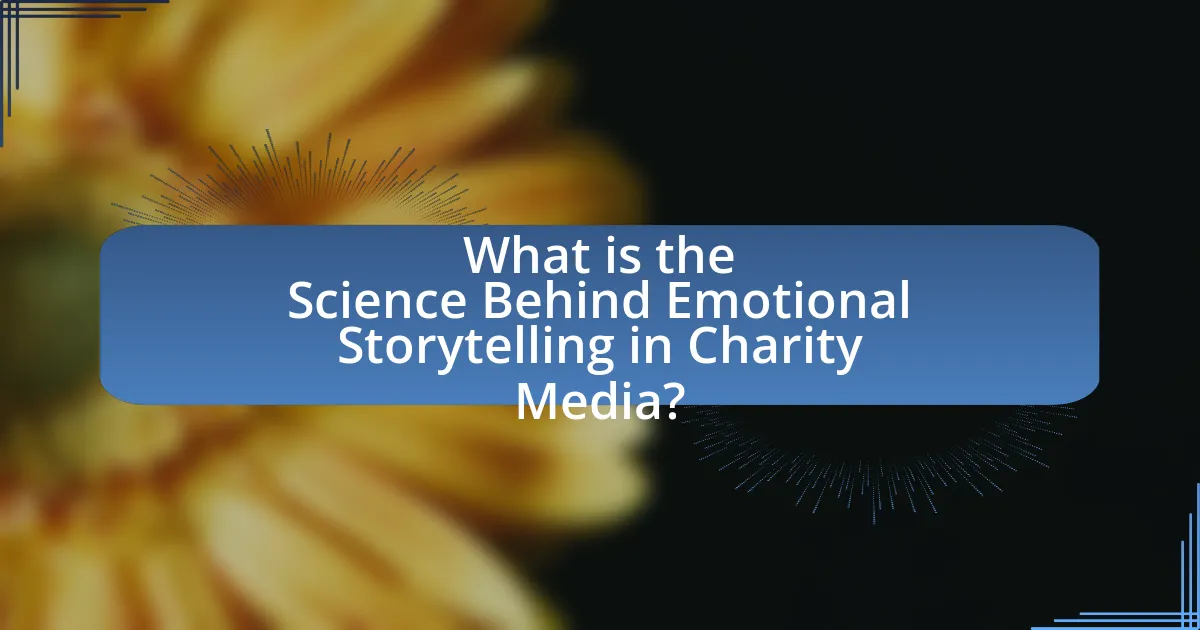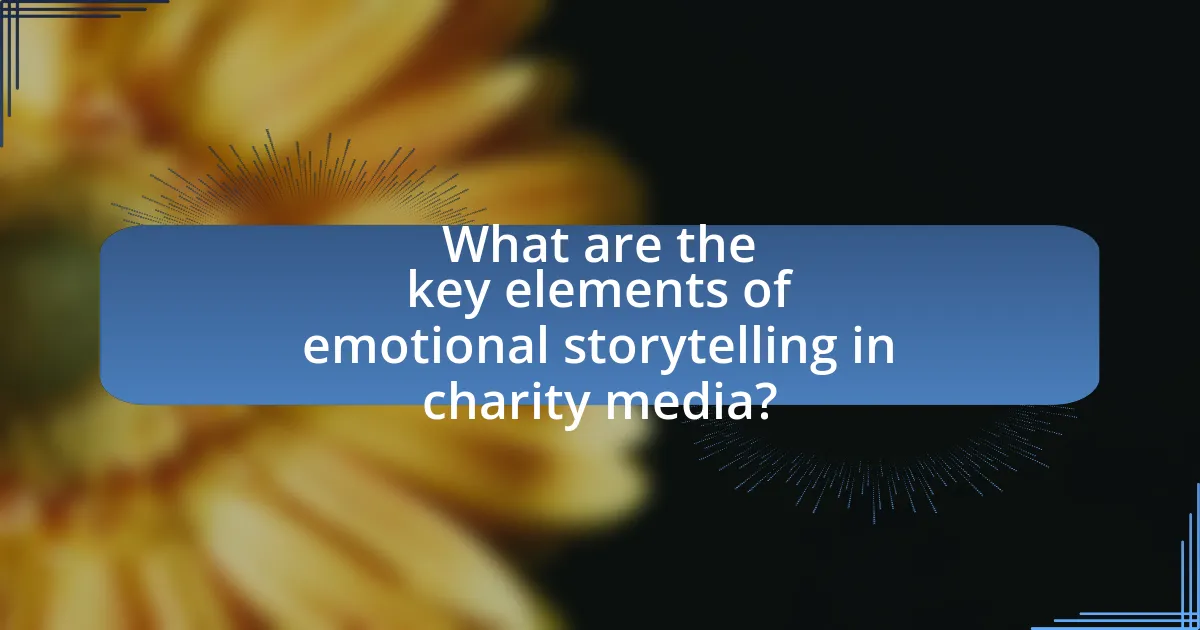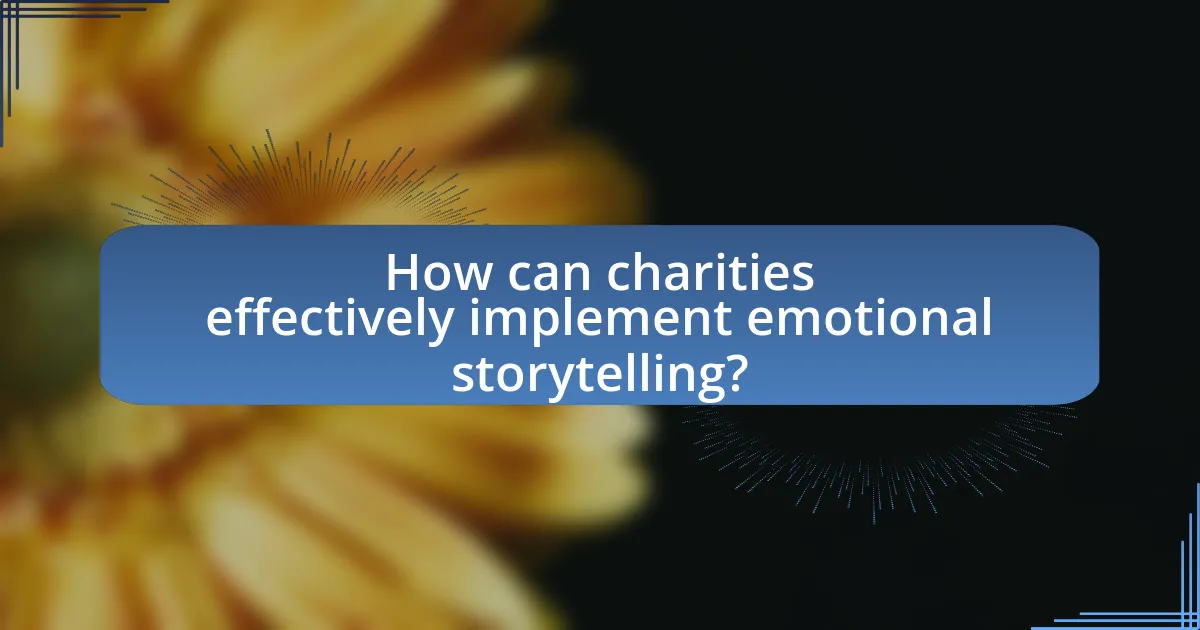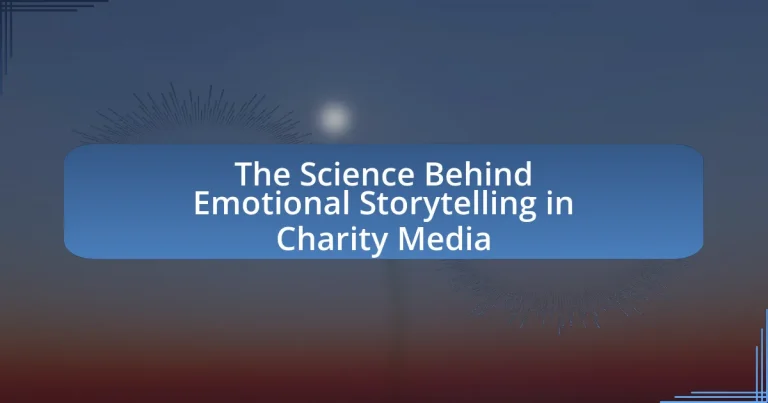The article explores the science behind emotional storytelling in charity media, emphasizing its psychological foundations and effectiveness in engaging audiences and driving donations. It highlights how narratives evoke empathy, activate emotional responses, and enhance prosocial behavior, supported by research findings. Key elements of effective emotional storytelling include relatable characters, compelling narratives, and emotional triggers, which collectively foster a connection between donors and beneficiaries. The article also addresses best practices for charities, potential pitfalls of emotional storytelling, and the importance of authenticity and clarity in crafting impactful narratives.

What is the Science Behind Emotional Storytelling in Charity Media?
Emotional storytelling in charity media leverages psychological principles to engage audiences and drive donations. Research indicates that narratives evoke empathy, which activates the brain’s emotional centers, leading to increased prosocial behavior. A study by Paul Zak, published in the journal “PLOS ONE,” found that stories that elicit strong emotional responses can increase oxytocin levels, enhancing feelings of connection and prompting altruistic actions. Additionally, emotional storytelling often incorporates relatable characters and situations, making the cause more tangible and compelling, which further motivates individuals to contribute.
How does emotional storytelling influence audience engagement in charity media?
Emotional storytelling significantly enhances audience engagement in charity media by creating a deeper connection between the audience and the cause. This connection is facilitated through relatable narratives that evoke empathy, prompting viewers to feel the urgency and importance of the issues presented. Research indicates that emotionally charged stories can increase donations by up to 50%, as they resonate more profoundly with individuals compared to factual presentations alone. For instance, a study published in the Journal of Marketing Research found that narratives that elicit strong emotional responses lead to higher levels of engagement and willingness to support charitable causes.
What psychological principles underpin emotional storytelling?
Emotional storytelling is underpinned by several psychological principles, including empathy, narrative transportation, and the affective response. Empathy allows individuals to connect with characters or situations, fostering a deeper emotional engagement. Narrative transportation refers to the immersive experience where audiences become absorbed in the story, leading to a shift in attitudes and beliefs. The affective response involves the emotional reactions elicited by the story, which can influence decision-making and behavior. Research by Green and Brock (2000) in “The Role of Transportation in the Persuasiveness of Public Narratives” demonstrates that narrative transportation significantly enhances persuasion, validating the importance of these psychological principles in effective emotional storytelling.
How do emotions drive decision-making in charitable giving?
Emotions significantly influence decision-making in charitable giving by creating a sense of empathy and urgency in potential donors. Research indicates that emotional appeals, such as storytelling that highlights personal experiences of beneficiaries, can increase the likelihood of donations. For instance, a study published in the journal “Psychological Science” found that individuals are more inclined to give when they feel a strong emotional connection to the cause, as emotions activate areas of the brain associated with decision-making and reward. This emotional engagement often leads to increased generosity, as donors are motivated by feelings of compassion and a desire to make a positive impact.
Why is emotional storytelling effective in charity campaigns?
Emotional storytelling is effective in charity campaigns because it creates a deep connection between the audience and the cause, fostering empathy and motivating action. Research indicates that narratives that evoke emotions can significantly enhance engagement; for instance, a study published in the Journal of Marketing Research found that emotionally charged stories can increase donation likelihood by up to 50%. This effectiveness stems from the ability of emotional storytelling to humanize the issues at hand, making them relatable and urgent, which in turn drives individuals to contribute to the cause.
What role does empathy play in emotional storytelling?
Empathy is crucial in emotional storytelling as it fosters a deep connection between the audience and the narrative. This connection enhances the audience’s emotional engagement, making them more likely to resonate with the characters and situations presented. Research indicates that stories eliciting empathy can lead to increased prosocial behavior, such as charitable giving. For instance, a study published in the journal “Psychological Science” by Small, Loewenstein, and Slovic found that individuals who felt empathy towards a character in a story were more inclined to donate to related causes. Thus, empathy not only enriches the storytelling experience but also drives action in the context of charity media.
How can narratives create a connection between donors and beneficiaries?
Narratives create a connection between donors and beneficiaries by evoking empathy and fostering emotional engagement. When stories highlight individual experiences and challenges faced by beneficiaries, they humanize the cause, making it relatable for donors. Research indicates that emotional storytelling can increase donations by up to 50%, as it taps into the donor’s feelings and motivates them to contribute. For instance, a study published in the Journal of Marketing Research found that narratives that include personal details about beneficiaries significantly enhance the likelihood of donor engagement. This connection is crucial in charity media, as it transforms abstract concepts of need into tangible human experiences, driving support and commitment from donors.

What are the key elements of emotional storytelling in charity media?
The key elements of emotional storytelling in charity media include relatable characters, compelling narratives, emotional triggers, and a clear call to action. Relatable characters, often individuals or communities facing challenges, create a personal connection with the audience. Compelling narratives engage viewers by presenting a journey or transformation, highlighting struggles and triumphs. Emotional triggers, such as joy, sadness, or empathy, evoke feelings that motivate the audience to respond. A clear call to action directs viewers on how they can help, making the emotional experience actionable. These elements work together to enhance engagement and drive support for charitable causes.
How do visuals enhance emotional storytelling?
Visuals enhance emotional storytelling by creating a direct emotional connection with the audience, facilitating empathy and engagement. Research indicates that images can evoke emotions more effectively than text alone; for instance, a study published in the journal “Emotion” found that visual stimuli can trigger emotional responses in the brain, leading to stronger memory retention and a greater likelihood of action. This is particularly relevant in charity media, where compelling visuals can illustrate the impact of a cause, making the narrative more relatable and urgent. By combining visuals with storytelling, organizations can amplify their message and motivate audiences to contribute or take action.
What types of imagery are most effective in charity storytelling?
Emotional imagery is the most effective type of imagery in charity storytelling. This includes visuals that evoke strong feelings such as compassion, empathy, and urgency. Research indicates that images depicting real people in need, particularly close-up shots that capture facial expressions and emotions, significantly enhance viewer engagement and response rates. For instance, a study published in the Journal of Nonprofit & Public Sector Marketing found that emotional appeals in imagery led to a 30% increase in donations compared to neutral imagery. Additionally, imagery that illustrates the impact of donations, such as before-and-after scenarios, reinforces the effectiveness of the storytelling by providing tangible evidence of change.
How does video content impact emotional responses?
Video content significantly impacts emotional responses by engaging viewers through visual storytelling, sound, and narrative structure. Research indicates that videos can evoke strong emotions such as empathy, joy, or sadness, which are crucial for effective communication in charity media. For instance, a study published in the journal “Emotion” by Nabi and Krcmar (2004) found that emotionally charged video content can lead to increased viewer engagement and a higher likelihood of charitable donations. This emotional engagement is facilitated by the combination of imagery, music, and relatable narratives that resonate with the audience, ultimately influencing their attitudes and behaviors towards charitable causes.
What narrative techniques are commonly used in charity storytelling?
Charity storytelling commonly employs narrative techniques such as personal anecdotes, emotional appeals, and character-driven narratives. Personal anecdotes create relatable connections by sharing individual stories of beneficiaries, which evoke empathy and understanding. Emotional appeals leverage feelings of compassion and urgency, often highlighting the impact of donations through vivid imagery and descriptive language. Character-driven narratives focus on specific individuals, allowing audiences to see the human side of the cause, making it more compelling. Research indicates that stories featuring a single protagonist can increase engagement and donations, as they foster a deeper emotional connection with the audience.
How does character development influence audience perception?
Character development significantly influences audience perception by shaping emotional connections and empathy towards the characters. When characters undergo growth or transformation, audiences are more likely to relate to their experiences, fostering a deeper emotional investment in the narrative. Research indicates that well-developed characters can evoke stronger emotional responses, which enhances the overall impact of the story. For instance, a study published in the Journal of Communication found that narratives featuring complex characters led to increased empathy and engagement among viewers, demonstrating that character depth directly correlates with audience perception and emotional response.
What is the significance of conflict and resolution in charity narratives?
Conflict and resolution in charity narratives are significant because they create emotional engagement, driving donor motivation and support. The presence of conflict highlights the challenges faced by individuals or communities, making the need for assistance clear and urgent. Resolution, on the other hand, illustrates the positive impact of donations, showcasing how contributions can lead to meaningful change. Research indicates that stories featuring conflict and resolution are more likely to elicit empathy and prompt action, as they resonate with the audience’s emotions and values. For instance, a study published in the Journal of Nonprofit & Public Sector Marketing found that narratives with a clear conflict and resolution structure increased the likelihood of donations by 30% compared to those without. This demonstrates that effectively crafted charity narratives can significantly enhance fundraising efforts by appealing to the emotional and rational aspects of potential donors.

How can charities effectively implement emotional storytelling?
Charities can effectively implement emotional storytelling by focusing on authentic narratives that connect with their audience’s values and emotions. This involves sharing real-life experiences of individuals impacted by the charity’s work, using vivid imagery and relatable language to evoke empathy. Research indicates that stories that highlight personal struggles and triumphs can increase engagement and donations; for instance, a study published in the Journal of Marketing Research found that emotional appeals in storytelling can enhance the likelihood of charitable giving by up to 50%. By prioritizing genuine stories and emotional resonance, charities can foster a deeper connection with their supporters, ultimately driving greater impact.
What strategies can charities use to craft compelling stories?
Charities can craft compelling stories by focusing on emotional resonance, authenticity, and clear messaging. Emotional resonance is achieved by highlighting personal experiences and relatable narratives that connect with the audience’s feelings. Authenticity is crucial; charities should share real stories from beneficiaries, ensuring that the narratives reflect genuine experiences and struggles. Clear messaging involves articulating the charity’s mission and impact succinctly, making it easy for the audience to understand the cause and its significance. Research indicates that stories that evoke empathy can increase donations by up to 50%, demonstrating the effectiveness of these strategies in engaging supporters and driving action.
How can charities identify and highlight personal stories?
Charities can identify and highlight personal stories by actively engaging with their beneficiaries and collecting testimonials that reflect individual experiences. This process involves conducting interviews, surveys, and focus groups to gather authentic narratives that resonate emotionally with potential donors. Research indicates that personal stories significantly enhance donor engagement; for instance, a study published in the Journal of Nonprofit & Public Sector Marketing found that storytelling can increase donations by up to 30%. By utilizing these methods, charities can effectively showcase the impact of their work through compelling personal accounts, thereby fostering a deeper connection with their audience.
What role does authenticity play in storytelling for charities?
Authenticity is crucial in storytelling for charities as it fosters trust and emotional connection with the audience. When charities present genuine narratives, they resonate more deeply with potential donors, leading to increased engagement and support. Research indicates that 70% of donors are more likely to contribute to organizations that share authentic stories about their impact, highlighting the importance of transparency and real experiences in building relationships. Authentic storytelling not only enhances credibility but also motivates individuals to act, as they feel a personal connection to the cause being presented.
What are the potential pitfalls of emotional storytelling in charity media?
Emotional storytelling in charity media can lead to several potential pitfalls, including donor fatigue, misrepresentation of beneficiaries, and ethical concerns regarding manipulation. Donor fatigue occurs when audiences become overwhelmed by constant emotional appeals, resulting in decreased engagement and contributions. Misrepresentation can arise when stories are overly dramatized, leading to a disconnect between the portrayed situation and the actual circumstances of beneficiaries, which can damage trust. Ethical concerns involve the risk of exploiting vulnerable individuals for emotional gain, raising questions about the morality of such practices. These pitfalls highlight the need for a balanced approach that maintains authenticity while effectively engaging audiences.
How can charities avoid manipulation in their narratives?
Charities can avoid manipulation in their narratives by adhering to ethical storytelling practices that prioritize transparency and authenticity. By providing accurate data and real-life testimonials, charities can build trust with their audience, ensuring that the narratives reflect genuine experiences rather than exaggerated claims. Research indicates that 70% of donors prefer organizations that are honest about their challenges and successes, highlighting the importance of integrity in communication. Furthermore, employing third-party evaluations and impact assessments can substantiate claims made in narratives, reinforcing credibility and reducing the risk of perceived manipulation.
What are the risks of oversaturation in emotional appeals?
Oversaturation in emotional appeals can lead to desensitization among audiences, diminishing the effectiveness of future messages. When individuals are repeatedly exposed to highly emotional content, they may become numb to the emotions being conveyed, resulting in reduced empathy and engagement. Research indicates that excessive emotional stimuli can trigger a defensive response, causing audiences to disengage rather than respond positively. For instance, a study published in the Journal of Consumer Research found that repeated exposure to emotional advertisements led to a decrease in emotional responses and purchase intentions over time. This highlights the critical balance needed in emotional storytelling, particularly in charity media, where the goal is to inspire action and support.
What best practices should charities follow for effective emotional storytelling?
Charities should focus on authenticity, relatability, and clarity for effective emotional storytelling. Authenticity ensures that the stories reflect real experiences and emotions, which fosters trust and connection with the audience. Relatability allows the audience to see themselves in the stories, making the message more impactful. Clarity in the narrative helps convey the message without confusion, ensuring that the audience understands the cause and its significance. Research indicates that stories that evoke empathy can increase donations by up to 50%, demonstrating the effectiveness of these practices in engaging supporters and driving action.
How can charities measure the impact of their storytelling efforts?
Charities can measure the impact of their storytelling efforts through various quantitative and qualitative metrics. These metrics include tracking engagement rates, such as shares, likes, and comments on social media platforms, which indicate how well the story resonates with the audience. Additionally, charities can analyze changes in donation levels before and after storytelling campaigns, providing concrete evidence of financial impact. Surveys and feedback forms can also be utilized to gather direct responses from the audience regarding their emotional connection to the stories shared. Research shows that emotional storytelling can increase donor retention rates by up to 50%, highlighting the effectiveness of this approach in fostering long-term relationships with supporters.
What tools and platforms can enhance storytelling in charity media?
Tools and platforms that can enhance storytelling in charity media include social media platforms, video editing software, and content management systems. Social media platforms like Facebook, Instagram, and Twitter allow charities to share compelling narratives and engage with audiences through visual and written content. Video editing software such as Adobe Premiere Pro and Final Cut Pro enables organizations to create impactful videos that convey emotional stories effectively. Content management systems like WordPress and Squarespace facilitate the organization and presentation of stories on websites, making it easier for charities to reach their target audience. These tools collectively improve the ability to tell engaging and emotional stories that resonate with supporters and drive donations.


